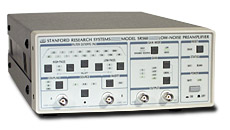Stanford Research SR560 Preamplifiers

Follow us for the latest equipment specials.
Refurbished Stanford Research SR560

Sell Equipment Repairs Add to cart E-mail this page Alert me when this goes on sale
Stanford Research SR560 Details
Stanford Research SR560
Low Noise Preamplifier
The SR560 is a high-performance, low-noise preamplifier that is ideal for a wide variety of applications including low-temperature measurements, optical detection, and audio engineering.
Inputs
The SR560 has a differential front end with 4 nV/?Hz input noise and an input impedance of 100 M?. Complete noise figure contours are shown in the graphs below. The SR560's inputs are fully floating (BNC shields are not connected to chassis ground). Both the amplifier ground and the chassis ground are available on the rear panel for flexibility in grounding the instrument. Input offset nulling is accomplished by a front-panel potentiometer, accessible with a small screwdriver.
In addition to the signal inputs, a rear-panel TTL blanking input lets you quickly turn off and on the instrument's gain. This is useful in preventing front-end overloading. The gain turns off 5 Micros after the TTL level goes high, and back on again within 10 Micros after the TTL signal goes low.
click to enlarge
Preamplifier Block Diagram
Outputs
Two insulated output BNC connectors provide 600 ? and 50 ? outputs. Both are capable of driving 10 Vpp into their respective loads. Two rear-panel power supply outputs provide up to 200 mA of +/-12 VDC referenced to the amplifier ground. The outputs provide clean DC power for use as a bias source.
Gain
Gains are selectable from 1 to 50,000 in a 1-2-5 sequence. An adjustable gain feature lets you specify the gain as a percentage of any of the fixed gain settings with 0.5 % resolution. Gain can be selectively allocated before the filters to optimize noise performance, or after the filters to reduce susceptibility to overloads.
click to enlarge
Dynamic Reserve
Filters
The SR560 contains two first-order RC filters whose cutoff frequency and type (HPF or LPF) can be configured from the front panel. Together, the filters can be configured as a 6 or 12 dB/oct rolloff low-pass or high-pass filter, or as a 6 dB/oct rolloff band-pass filter. A filter reset button is included to shorten the overload recovery time of the instrument when long filter time constants are being used. Filter cutoff frequencies can be set in a 1-3-10 sequence from 0.03 Hz to 1 MHz.
Battery Operation
Three internal, rechargeable, lead-acid batteries provide up to 15 hours of battery powered operation. An internal battery charger automatically charges the batteries when the unit is connected to the line. The charger senses the battery state and adjusts the charging rate accordingly. Two rear-panel LEDs indicate the charge state of the batteries. When the batteries become discharged, they are automatically disconnected from the amplifier circuit to avoid battery damage.
No Digital Noise
The microprocessor that runs the SR560 is "asleep" except during the brief interval it takes to change the instrument's setup. This ensures that no digital noise will contaminate low-level analog signals.




